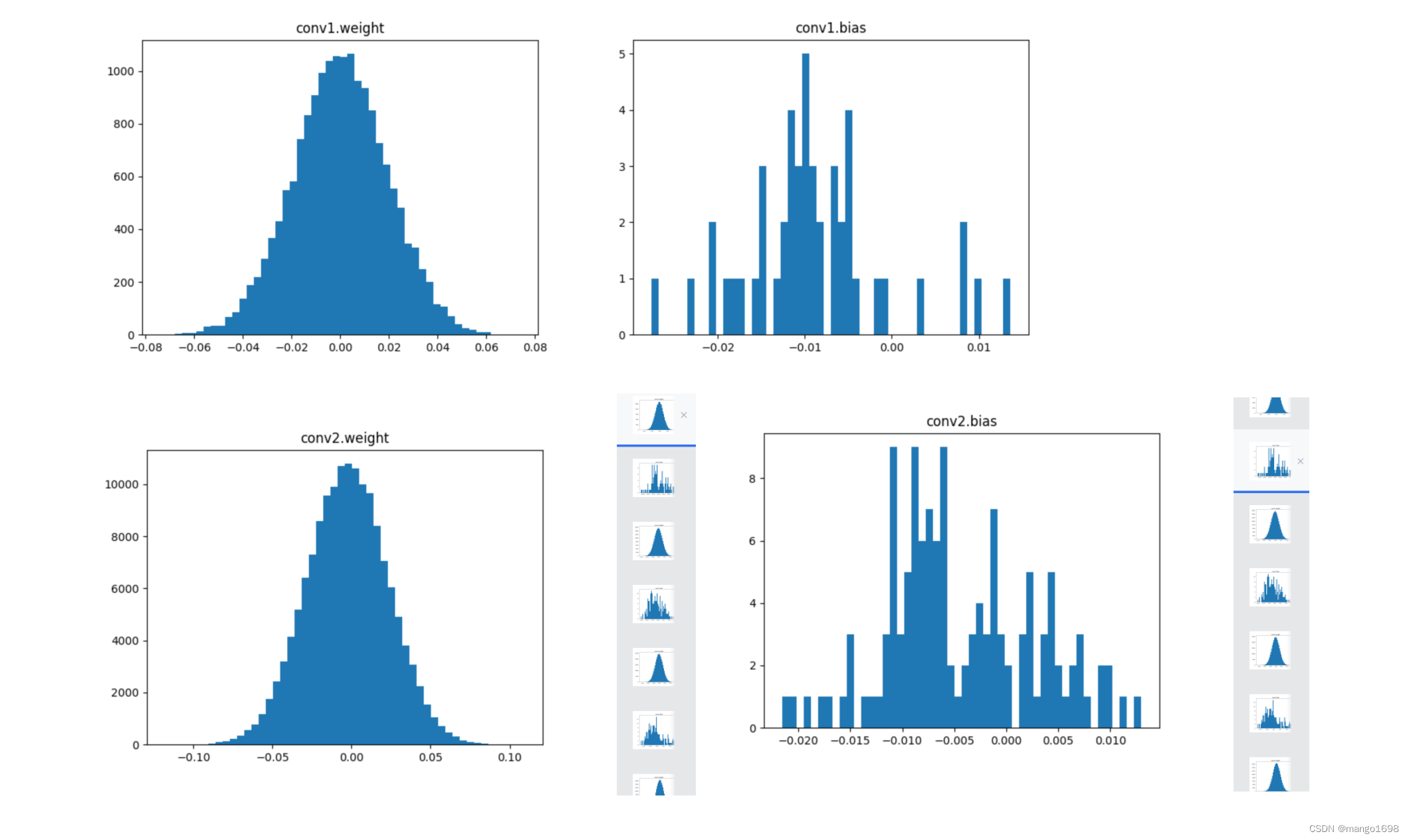查看神经网络中间层特征矩阵及卷积核参数
创始人
2024-12-29 01:33:41
0次
可视化feature maps以及kernel weights,使用alexnet模型进行演示。
1. 查看中间层特征矩阵
alexnet模型,修改了向前传播
import torch from torch import nn from torch.nn import functional as F # 对花图像数据进行分类 class AlexNet(nn.Module): def __init__(self,num_classes=1000,init_weights=False, *args, **kwargs) -> None: super().__init__(*args, **kwargs) self.conv1 = nn.Conv2d(3,48,11,4,2) self.pool1 = nn.MaxPool2d(3,2) self.conv2 = nn.Conv2d(48,128,5,padding=2) self.pool2 = nn.MaxPool2d(3,2) self.conv3 = nn.Conv2d(128,192,3,padding=1) self.conv4 = nn.Conv2d(192,192,3,padding=1) self.conv5 = nn.Conv2d(192,128,3,padding=1) self.pool3 = nn.MaxPool2d(3,2) self.fc1 = nn.Linear(128*6*6,2048) self.fc2 = nn.Linear(2048,2048) self.fc3 = nn.Linear(2048,num_classes) # 是否进行初始化 # 其实我们并不需要对其进行初始化,因为在pytorch中,对我们对卷积及全连接层,自动使用了凯明初始化方法进行了初始化 if init_weights: self._initialize_weights() def forward(self,x): outputs = [] # 定义一个列表,返回我们要查看的哪一层的输出特征矩阵 x = self.conv1(x) outputs.append(x) x = self.pool1(F.relu(x,inplace=True)) x = self.conv2(x) outputs.append(x) x = self.pool2(F.relu(x,inplace=True)) x = self.conv3(x) outputs.append(x) x = F.relu(x,inplace=True) x = F.relu(self.conv4(x),inplace=True) x = self.pool3(F.relu(self.conv5(x),inplace=True)) x = x.view(-1,128*6*6) x = F.dropout(x,p=0.5) x = F.relu(self.fc1(x),inplace=True) x = F.dropout(x,p=0.5) x = F.relu(self.fc2(x),inplace=True) x = self.fc3(x) # for name,module in self.named_children(): # x = module(x) # if name == ["conv1","conv2","conv3"]: # outputs.append(x) return outputs # 初始化权重 def _initialize_weights(self): for m in self.modules(): if isinstance(m,nn.Conv2d): # 凯明初始化 - 何凯明 nn.init.kaiming_normal_(m.weight, mode='fan_out', nonlinearity='relu') if m.bias is not None: nn.init.constant_(m.bias, 0) elif isinstance(m,nn.Linear): nn.init.normal_(m.weight, 0,0.01) # 使用正态分布给权重赋值进行初始化 nn.init.constant_(m.bias,0) 拿到向前传播的结果,对特征图进行可视化,这里,我们使用训练好的模型,直接加载模型参数。
注意,要使用与训练时相同的数据预处理。
import matplotlib.pyplot as plt from torchvision import transforms import alexnet_model import torch from PIL import Image import numpy as np from alexnet_model import AlexNet # AlexNet 数据预处理 transform = transforms.Compose([ transforms.Resize((224, 224)), transforms.ToTensor(), transforms.Normalize((0.5, 0.5, 0.5), (0.5, 0.5, 0.5)) ]) device = torch.device("mps" if torch.backends.mps.is_available() else "cpu") # 实例化模型 model = AlexNet(num_classes=5) weights = torch.load("./alexnet_weight_20.pth", map_location="cpu") model.load_state_dict(weights) image = Image.open("./images/yjx.jpg") image = transform(image) image = image.unsqueeze(0) with torch.no_grad(): output = model(image) for feature_map in output: # (N,C,W,H) -> (C,W,H) im = np.squeeze(feature_map.detach().numpy()) # (C,W,H) -> (W,H,C) im = np.transpose(im,[1,2,0]) plt.figure() # 展示当前层的前12个通道 for i in range(12): ax = plt.subplot(3,4,i+1) # i+1: 每个图的索引 plt.imshow(im[:,:,i],cmap='gray') plt.show() 结果:

2. 查看卷积核参数
import matplotlib.pyplot as plt import numpy as np import torch from AlexNet.model import AlexNet # 实例化模型 model = AlexNet(num_classes=5) weights = torch.load("./alexnet_weight_20.pth", map_location="cpu") model.load_state_dict(weights) weights_keys = model.state_dict().keys() for key in weights_keys: if "num_batches_tracked" in key: continue weight_t = model.state_dict()[key].numpy() weight_mean = weight_t.mean() weight_std = weight_t.std(ddof=1) weight_min = weight_t.min() weight_max = weight_t.max() print("mean is {}, std is {}, min is {}, max is {}".format(weight_mean, weight_std, weight_min, weight_max)) weight_vec = np.reshape(weight_t,[-1]) plt.hist(weight_vec,bins=50) plt.title(key) plt.show() 结果:

相关内容
热门资讯
信息共享(德州ai人工智能)德...
信息共享(德州ai人工智能)德州ai辅助(素来真的是有挂)-哔哩哔哩,亲,有的,ai轻松简单,又可以...
我来向大家传授!微扑克ai胜率...
我来向大家传授!微扑克ai胜率,微扑克透牌(微扑克)一贯是真的有挂(有挂方法)-哔哩哔哩1)微扑克a...
辅助黑科技“wepokeai代...
辅助黑科技“wepokeai代打”wepoke软件透明演示(透明挂黑科技)竟然是有挂(有挂工具)-哔...
查到实测辅助“wpk最新黑科技...
您好,wpk最新黑科技这款游戏可以开挂的,确实是有挂的,需要了解加微【136704302】很多玩家在...
技巧知识分享(德州辅助神器软件...
1、技巧知识分享(德州辅助神器软件)德州AI辅助神器(本来是真的有挂)-哔哩哔哩;详细教程。2、德州...
分享给玩家!微扑克有透视挂吗,...
分享给玩家!微扑克有透视挂吗,微扑克透牌(微扑克)切实存在有挂(有挂方针)-哔哩哔哩;1)微扑克有透...
黑科技脚本“wepoke有没有...
黑科技脚本“wepoke有没有挂”wepoke到底有没有挂(透明挂)好像真的有挂(了解有挂)-哔哩哔...
让我来分享经验“wpk ai辅...
让我来分享经验“wpk ai辅助”wpk提高胜率(wpK)总是存在有挂(有挂透明挂)-哔哩哔哩1、每...
最新技巧!微扑克辅助工具,微扑...
最新技巧!微扑克辅助工具,微扑克透牌(微扑克)总是真的有挂(的确有挂)-哔哩哔哩1、任何微扑克辅助工...
重大发现(德州ai软件购买)德...
自定义德州之星辅助挂系统规律,只需要输入自己想要的开挂功能,一键便可以生成出微扑克专用辅助器,不管你...
